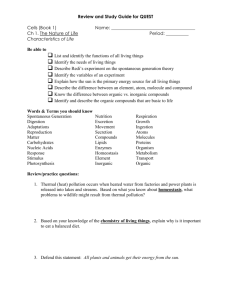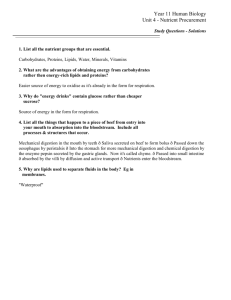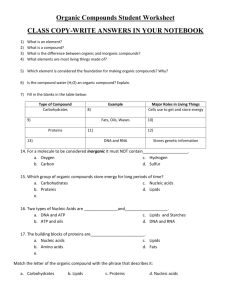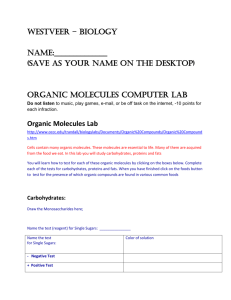Organic Compounds
advertisement
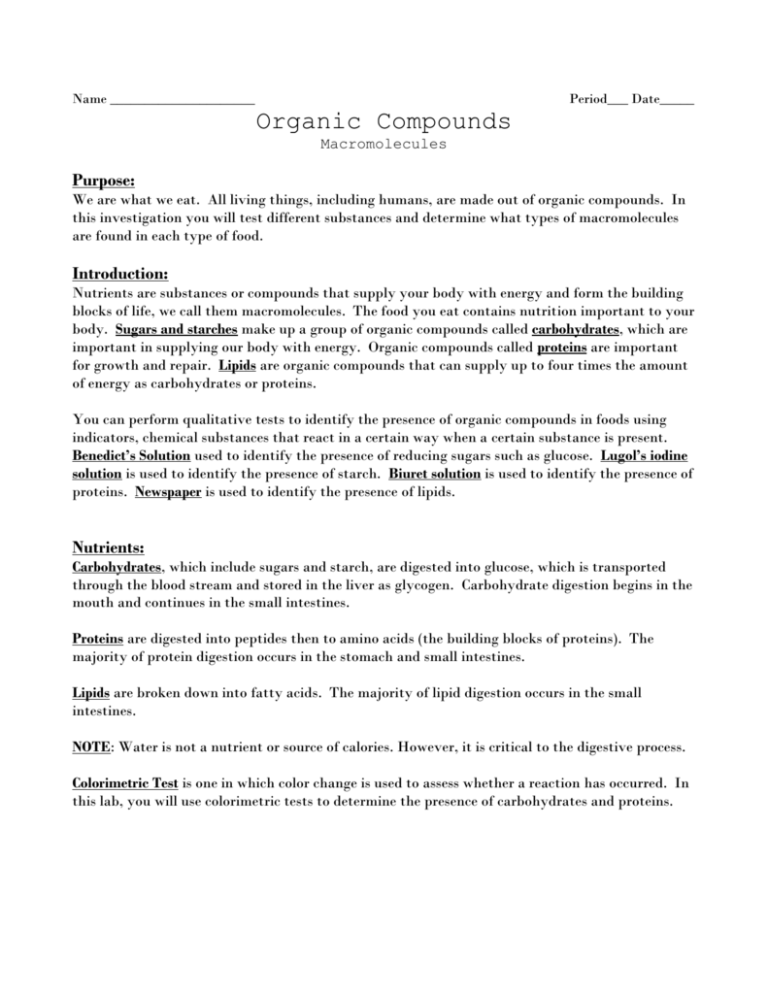
Name _____________________ Period___ Date_____ Organic Compounds Macromolecules Purpose: We are what we eat. All living things, including humans, are made out of organic compounds. In this investigation you will test different substances and determine what types of macromolecules are found in each type of food. Introduction: Nutrients are substances or compounds that supply your body with energy and form the building blocks of life, we call them macromolecules. The food you eat contains nutrition important to your body. Sugars and starches make up a group of organic compounds called carbohydrates, which are important in supplying our body with energy. Organic compounds called proteins are important for growth and repair. Lipids are organic compounds that can supply up to four times the amount of energy as carbohydrates or proteins. You can perform qualitative tests to identify the presence of organic compounds in foods using indicators, chemical substances that react in a certain way when a certain substance is present. Benedict’s Solution used to identify the presence of reducing sugars such as glucose. Lugol’s iodine solution is used to identify the presence of starch. Biuret solution is used to identify the presence of proteins. Newspaper is used to identify the presence of lipids. Nutrients: Carbohydrates, which include sugars and starch, are digested into glucose, which is transported through the blood stream and stored in the liver as glycogen. Carbohydrate digestion begins in the mouth and continues in the small intestines. Proteins are digested into peptides then to amino acids (the building blocks of proteins). The majority of protein digestion occurs in the stomach and small intestines. Lipids are broken down into fatty acids. The majority of lipid digestion occurs in the small intestines. NOTE: Water is not a nutrient or source of calories. However, it is critical to the digestive process. Colorimetric Test is one in which color change is used to assess whether a reaction has occurred. In this lab, you will use colorimetric tests to determine the presence of carbohydrates and proteins. Topic I: Carbohydrates: Iodine Test for Starch: If starch is present then the solution will turn from yellow to blue/black in the presence of iodine (I2KI). Benedicts Test For Sugar: If sugar is present then the solution will turn from blue to green, orange, or brown in the presence of Benedict’s solution. Starch + Iodine blue/black color Sugar + Benedict’s solution green/orange/brown Part A: Testing for Carbohydrates (Starch): Group Substance Added Water 1 2 3 4 5 6 7 8 Apple Juice Egg White Potato Pizza Sprite Chips Cereal Pasta Table A Reagent and color of reagent Color observed after test Part B: Testing for Carbohydrates (Sugar): Appearance After Test: Amount of sugar: Color Group 0 (none) + (trace) ++ (little) +++ (some) ++++ (much) Blue Blue-green Green Yellow Orange/red Substance Added Table B Reagent and color of reagent Color observed after test Water 1 2 3 4 5 6 7 8 Apple Juice Egg White Potato Pizza Sprite Chips Cereal Pasta Question: List two places in the body where carbohydrate digestion occurs. _____________________________ Which food substance(s) contains the most starch?_________________________________________ Which food substance(s) contains the most sugar?_________________________________________ Topic II: Proteins: If proteins are present, the solution will turn pink (some protein) to purple (much protein) when Biuret solution is added. Part C: Testing for Proteins: Group Substance Added Table C Reagent and color of reagent Water 1 2 3 4 5 6 7 8 Apple Juice Egg White Potato Pizza Sprite Chips Cereal Pasta Question: List two places in the body where proteins digestion occurs. _________________________________ Which food substance(s) contains the most protein?________________________________________ Which food substance(s) contains no protein?_____________________________________________ Color observed after test Topic III: Lipids: Part D: Testing for Lipids: Group Substance Added Table D Reagent and color of reagent Color observed after test Water Oil 1 2 3 4 5 6 7 8 Apple Juice Egg White Potato Pizza Sprite Chips Cereal Pasta Questions: Name one place in the body where lipid digestion takes place. ________________________________ Which food substance(s) contain the most lipids? __________________________________________ Which food substance(s) contain the most lipids? __________________________________________ CONCLUSION: Write a conclusion for this lab activity. This must be in paragraph form! Use the questions from the lab and the following questions to guide you: What are macromolecules? What are the different categories or groups? What is a colorimetric test? How did you test for each organic compound? Why do we use one test tube with only water? Explain the results for the substances that you tested.
